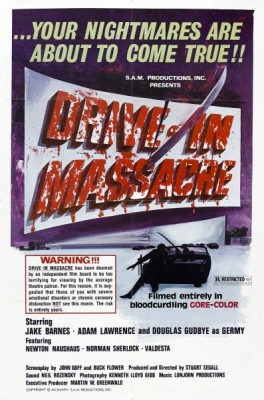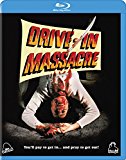| Reviews & Columns |
|
Reviews DVD TV on DVD Blu-ray 4K UHD International DVDs In Theaters Reviews by Studio Video Games Features Collector Series DVDs Easter Egg Database Interviews DVD Talk Radio Feature Articles Columns Anime Talk DVD Savant Horror DVDs The M.O.D. Squad Art House HD Talk Silent DVD
|
DVD Talk Forum |
|
|
| Resources |
|
DVD Price Search Customer Service #'s RCE Info Links |
|
Columns
|
|
|
Drive In Massacre
Seen today, the picture also offers viewers the opportunity to soak in the slightly seedy ambiance of a real (recently closed when the film was made) drive-in theater, that form of movie exhibition on the downslide by the 1970s. For this critic it brought back a lot of memories.
Some have described this as an exploitation variation of Peter Bogdanovich's Targets (1968); both feature a drive-in theater where many are killed, but that's where the similarities end. With clinical precision Targets contrasted the fairy tale like storytelling of classical horror movies with the movements of a Charles Whitman-like sniper coldly committing mass murder. Drive In Massacre (sic) is straightforward exploitation.
A Severin release culled from an original camera negative, reportedly "discovered in the ruins of the Sky View Drive-In Movie Theater in Oregon!" the disc is loaded with appealing and informative extra features.
The plot is so simple as to be almost schematic. Cars roll into the Simi Drive-In, where manager Austin Johnson (Robert E. Pearson), sporting "a chip on his shoulder the size of the national debt," as Rod Serling might have said, berates every single customer. During the movie, an unseen assailant murders a couple on a date with his long sword, decapitating him and skewering her.
World-weary - boy, are they ever - police detectives Mike Leary (co-writer Goff) and John Koch (Bruce Kimball) are assigned to the case. Clues lead them first to the drive-in's halfwit custodian, Charlie "Germy" Garmey (Douglas Gudbye, who kept reminding me of comedian Howard Morris), a former sword-swallower when a circus owned by the same absent landlord occupied the site, a circus where Johnson also worked, as a barker and knife-thrower.
The flatfoots also begin to suspect an obsessive peeping tom, Orville Ingleson (Norman Sheridan), who gets off spying couples at the drive-in making out or (presumably) having sex.
Meanwhile, the killer continues his spree, grimly slicing and stabbing two or more customer each subsequent night. You'd think this would deter business, but then again, the press seems unaware as no reporters turn up and the cars keep rolling in.
Made independently and theatrically distributed by fringe outfit Dimension Pictures (Beyond Atlantis, Dolemite, Kingdom of the Spiders), Drive In Massacre exhibits a bit of William Castle-esque showmanship, advertising touting that was "filmed entirely in bloodcurdling Gore-Color" and warning that an "independent film board" deemed the film too terrifying for the average viewer. Without giving too much away, the feature ends abruptly, with a Castlesque announcement, supposedly made over the theater's public address system, warning that the killer is loose in the very theater playing Drive In Massacre, though this is too abrupt and clumsily done to be effective.
Where the movie impresses is the lengths it goes to make the characters more than cipher victims and suspects. Peeping tom Orville, for instance, with his comical Pied Piper hat, first looks like a character out of an early '60s nudie-cutie, but when the detectives question him at his home, decorated with centerfold tacked to the walls, he comes off as a three-dimensional, pathetic nobody all too aware of his dead-end existence. None of the victims are teenagers, but adults in their 20s and 30s. They have these actorly, almost mini one act-type vignettes that make them more sympathetic and/or interesting than those usually found in slasher movies. One couple is excited about moving into a new apartment so that they won't have to go to the drive-in anymore to make love. Another consists of a married man having an affair, whose frustrated lover announces that she's pregnant. Clearly the credit for all this goes to writers Goff and Flower, actors themselves. (Flower has a small role as a machete-wielding man.)
The pair had previously acted leading roles in The Devil and Leroy Bassett (1973; it's the movie heard but never seen in Drive In Massacre), an obscure modern Western written and directed by Robert E. Pearson, who plays the surly theater manager. Thoroughly unpleasant, Austin Johnson sports a shaved head and close-cropped but thick brown beard, loud, patterned sports jackets and he wears a big wooden cross with turquoise highlights. He looks like a character out of a Russ Meyer movie, and in fact appears in Beneath the Valley of the Ultra-Vixens (1979). Pearson's performance is memorably grating.
Drive-Ins are, of course, virtually extinct, but had been extremely popular particularly in rural America and beyond the suburbs of bigger cities, like the Simi Drive-In in the Valley north of Los Angeles. Most drive-ins went into decline during the 1970s, some switching to exploitation fare (after flirting with mainstream, if second-run studio fare the previous decade) and even porno. From a spectatorship standpoint, drive-ins were a truly terrible way to watch movies. The projection, often beginning before it was even dark, was frequently poor, and the audio quality from those clunky speakers even worse.
Yet even under such dire viewing conditions drive-ins had a magical air about them - their elaborate, tantalizing concession stands and meager playgrounds for unruly children not interested in the movie - and Drive In Massacre accurately captures that form of exhibition in its dying days.
Video & Audio
Filmed for 1.85:1 widescreen, Drive In Massacre looks great on Blu-ray. The titles are ugly and grainy, but the rest of the picture looks great. The DTS-HD 2.0 Master Audio, English and Spanish mono, does wonders with the music and effects track, but the on-set sound recording is notably poor; it's even hard to make out the dialogue at times. The disc itself is region-free and English subtitles are offered.
Extra Features
The excellent supplements consist of both an audio commentary by and on-camera interview with director Stu Segall, interviews with actor/co-writer Goff, and actor Norman Sheridan, as well as a trailer. All entertaining material.
Parting Thoughts
Better than I expected, for horror and slasher fans, Drive In Massacre is Recommended.
Stuart Galbraith IV is the Kyoto-based film historian largely absent from reviewing these days while he restores a 200-year-old Japanese farmhouse.
|
| Popular Reviews |
| Sponsored Links |
|
|
| Sponsored Links |
|
|
| Release List | Reviews | Shop | Newsletter | Forum | DVD Giveaways | Blu-Ray | Advertise |
|
Copyright 2024 DVDTalk.com All Rights Reserved. Legal Info, Privacy Policy, Terms of Use,
Manage Preferences,
Your Privacy Choices | |||||||















